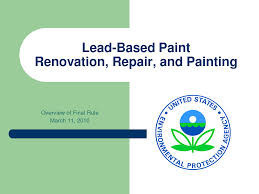Blacktrail's Lead-Based Paint Inspectors and Risk Assessors complete full lead-based paint surveys for lead in paint, soil, and even dust. Our Inspectors and Risk Assessors are licensed by the NDDH, trained, and attend annual continuing education classes. Our Licensed Inspectors and Risk Assessors can evaluate residential properties and commercial buildings and prepare a report identifying where lead-based paint and lead hazards are located in your building.
You can be exposed to lead any time you breathe lead dust or fumes, or swallow anything that contains lead. Lead poisoning is a concern for both children and adults. It can cause: permanent problems with health, learning and behavior in children, high blood pressure, kidney damage and fertility problems in adults. About 75 percent of the homes built before 1978 contain some lead-based paint. The older the home, the more likely it is to contain lead-based paint. You should assume that any home built before 1978 contains some lead. To be sure, test your home for lead following the advice from the NDDH and the USEPA. Start with calling Blacktrail for a consultant.
Who is at risk for lead poisoning? Property owners remodeling pre-1978 homes, their families, their neighbors, hired workers, and children.The older of these are very likely to contain lead. Older homes may have many layers of paint. If these are disturbed during remodeling these older layers can become high-risk areas. Lead dust is easy to pick up through your hair, skin, or clothing that can then be passed to other family members or those working on the project with you.
What are the
symptoms of lead poisoning?
There is no precise direct correlation between blood level and clinical
manifestations. Children with blood lead levels greater than 100 ug/dl may occasionally appear clinically well, and children with blood lead level 30-35 ug/dl may be symptomatic. The probability of
severe symptoms increases with the increase in exposure to lead, and is greater the higher the blood lead level is.
If blood lead levels are low, there may be no obvious symptoms of lead poisoning, although even low levels of lead may alter physiology and impact child development. Studies have shown an increase of blood lead from 10 ug/dl to 20 ug/dl results in an average decrease in IQ of approximately 2 points. That is why it is important to screen young children for lead poisoning.
Symptoms in young
children may develop insidiously and may abate spontaneously.
The following symptoms may occur:
- Gastrointestinal - anorexia, sporadic vomiting, intermittent abdominal pain (colic) or constipation.
- Central Nervous System - behavior changes, hyperactivity, aggression impulsiveness, irritability, lack of interest in play, lethargy, development delays, reversal in verbalization, loss of motor skills, clumsiness, short attention span or leaning disabilities.
- Hematologic - anemic, pallor
- Cardiovascular - hypertension, bardycardia
- Encephalopathy may occur as toxic damage to the brain progresses - sudden onset of persistent vomiting; sever ataxia (loss of coordination), altered state of consciousness, coma, seizures or massive cerebral edema in younger children. Encaphalopathy rarely occurs in blood lead levels under 100 ug/dl.
- Nonspecific or vague symptoms include abdominal pain, vomiting, constipation, anorexia, headache and fever.
What
complications can occur from lead poisoning?
Severe and often permanent mental, emotional and physical impairment can result from lead poisoning. In addition, neurological deficits such as learning
disabilities, mental retardation, seizures and Encephalopathy may occur.
* Information Provided by NDDH and USEPA




